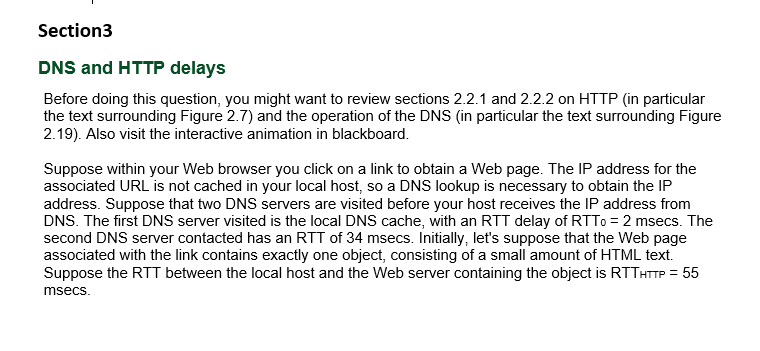

Section 3 DNS and HTTP delays Before doing this question, you might want to review sections 2.2.1 and 2.2.2 on HTTP (in particular the text surrounding Figure 2.7) and the operation of the DNS (in particular the text surrounding Figure 2.19). Also visit the interactive animation in blackboard. Suppose within your web browser you click on a link to obtain a Web page. The IP address for the associated URL is not cached in your local host, so a DNS lookup is necessary to obtain the IP address. Suppose that two DNS servers are visited before your host receives the IP address from DNS. The first DNS server visited is the local DNS cache, with an RTT delay of RTTO = 2 msecs. The second DNS server contacted has an RTT of 34 msecs. Initially, let's suppose that the web page associated with the link contains exactly one object, consisting of a small amount of HTML text. Suppose the RTT between the local host and the Web server containing the object is RTTHTTP = 55 msecs. RT1 RTT HTTP RTTO local DNS cache client 13. Assuming zero transmission time for the HTML object, how much time elapses from when the client clicks on the link until the client receives the object? 14. Visit the interactive DNS animation in blackboard, play around with the recursive and iterative query, write short notes of not more than 5 sentences about the impact of caching and the iterative/recursive DNS. Section 3 DNS and HTTP delays Before doing this question, you might want to review sections 2.2.1 and 2.2.2 on HTTP (in particular the text surrounding Figure 2.7) and the operation of the DNS (in particular the text surrounding Figure 2.19). Also visit the interactive animation in blackboard. Suppose within your web browser you click on a link to obtain a Web page. The IP address for the associated URL is not cached in your local host, so a DNS lookup is necessary to obtain the IP address. Suppose that two DNS servers are visited before your host receives the IP address from DNS. The first DNS server visited is the local DNS cache, with an RTT delay of RTTO = 2 msecs. The second DNS server contacted has an RTT of 34 msecs. Initially, let's suppose that the web page associated with the link contains exactly one object, consisting of a small amount of HTML text. Suppose the RTT between the local host and the Web server containing the object is RTTHTTP = 55 msecs. RT1 RTT HTTP RTTO local DNS cache client 13. Assuming zero transmission time for the HTML object, how much time elapses from when the client clicks on the link until the client receives the object? 14. Visit the interactive DNS animation in blackboard, play around with the recursive and iterative query, write short notes of not more than 5 sentences about the impact of caching and the iterative/recursive DNS








